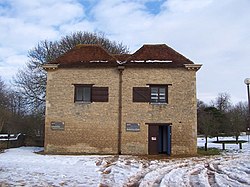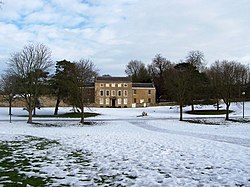Great Linford
| Great Linford | |
| Buckinghamshire | |
|---|---|
 The Pavilion Great Linford Arts Centre | |
| Location | |
| Grid reference: | SP854414 |
| Location: | 52°4’5"N, 0°45’49"W |
| Data | |
| Population: | 19,350 (2011[1]) |
| Post town: | Milton Keynes |
| Postcode: | MK14 |
| Dialling code: | 01908 |
| Local Government | |
| Council: | Milton Keynes |
| Parliamentary constituency: |
Milton Keynes North |
Great Linford is a village and parish in the Newport Hundred of Buckinghamshire that now forms a suburb in the northern part of Milton Keynes, between Wolverton and Newport Pagnell.
Great Linford village
Great Linford was one of the North Buckinghamshire villages incorporated into Milton Keynes at its designation in 1967.
Written as Great Linford to distinguish it from the even tinier Little Linford, the village is another on the Grand Union Canal. The name Linford is thought to derive from the crossing point over the River Ouse which now separates Great Linford from Little Linford to the north, where there were linden trees. The first reference to Linford occurs in 944, when "King Edmund gave to his thegn Aelfheah, land at Linforda with liberty to leave it to whom he wished"; it appears in the Domesday Book as Linforda.[2] Today, the outer buildings of the seventeenth-century Linford Manor form an Arts Centre, and the house itself is a recording studio.
In the early sixteenth century, the rector of this parish Dr Richard Napier was widely known as a medical practitioner, astrologer and curer of souls.[3] He was referred to by many in the upper classes, including the Earl of Sunderland who lived under his care for some time in 1629.[4]
Between 1817 and 1864 the village was the site of the junction between the Newport Pagnell Canal and the Grand Junction Canal.[5]
For a hundred years (1867 to 1967) Great Linford was served by Great Linford railway station on the Wolverton to Newport Pagnell branch line.
St Andrews C. of E. Infant School, on the High Street, founded in 1901, has survived various threats of closure from the local education authorities. The school was also home to Sir William Pritchard in the later part of that century, who was president of St Bartholomew's Hospital in London. He founded almshouses in Great Linford, which are still there today. As part of the development of Great Linford's integration into Milton Keynes, a new primary and middle school was opened in 1977, originally known as Great Linford County Combined School, and more recently as Great Linford Primary School.
The parish church of Saint Andrew is a Grade-II* listed building[6] and dates from 1215.[7]
Great Linford has two pubs: The Nag's Head, on the High Street and The Black Horse at the edge of Great Linford, by the Grand Union Canal.
Linford Manor
- Main article: Linford Manor
Linford Manor, also known as Great Linford Manor, is a seventeenth-century mansion or manor house converted into a recording studio complex in Great Linford. It is now owned by Pete Winkelman, chairman of Milton Keynes Dons.[8]
The former stables and associated gate houses are now an Arts Centre.[9] The former almshouses beside the stables are now used as artists' studios.
Civil parish
In addition to Great Linford district itself (with the historic village at its core), the civil parish also includes the districts of Giffard Park, Blakelands, Neath Hill, Pennyland, Tongwell, Conniburrow, Downs Barn, Downhead Park.
The parish is bounded to the north by Newport Road, to the west by the B4034/V8 Marlborough Street (as far as H4 Dansteed Way), then along Dansteed Way as far as V7 Saxon Street, south along Saxon Street as far as the A509/H5 Portway, then east along Portway to the M1, then north along the motorway until it reaches Newport Road again. The Grand Union Canal bisects the parish.
The parish increased in population from 263 in the 1971 census to 11,882 in the 1981 census, an increase of some 4,400%.
Little Linford is in the adjoining parish of Haversham-cum-Little Linford. Linford Wood is in the adjoining Stantonbury parish.
References
- ↑ Neighbourhood Statistics 2011 Census, Accessed 4 February 2013
- ↑ 'Parishes : Great Linford', Victoria History of the Counties of England, A History of the County of Buckingham: Volume 4 (1927), pp. 387–392. Date accessed: 21 September 2009
- ↑ 'Parishes : Great Linford', Victoria History of the Counties of England, A History of the County of Buckingham: Volume 4 (1927), pp. 387–392. Date accessed: 21 September 2009, See under "Advowson"
- ↑ "Great Linford". GEN UKI. Archived from the original on 11 September 2011. https://web.archive.org/web/20110911171033/http://met.open.ac.uk/genuki/big/eng/BKM/GreatLinford/index.html. Retrieved 9 January 2012.
- ↑ Hadfield, Charles (1970). The Canals of the East Midlands (including part of London) (Second ed.). David & Charles (Publishers) Limited. pp. 272–273. ISBN 071534871X.
- ↑ British Listed buildings, retrieved 4 July 2013
- ↑ Richard Geytyngdon, former parson, in 1381; 4th entry; http://aalt.law.uh.edu/AALT6/R2/CP40no483/483_0579.htm (in accordance with George Lipscomb's list)
- ↑ Jackson, Jamie (30 March 2008). "From Wimbledon to Winkelman, a crazy new journey". The Observer. https://www.theguardian.com/sport/2008/mar/30/football.newsstory2. Retrieved 9 January 2012.
- ↑ ["Archived copy". Archived from the original on 30 July 2012. https://archive.is/20120730061901/http://www.artworks-mk.co.uk/home/our-sites/great-linford-site/. Retrieved 2012-07-30. Artworks MK – Great Linford site
Outside links
| ("Wikimedia Commons" has material about Great Linford) |
